An Innovative Approach to Predict the Diffusion Rate of Reactant’s Effects on the Performance of the Polymer Electrolyte Membrane Fuel Cell
Abstract
:1. Introduction
2. Mathematical Model
2.1. Model Assumption and Description
- Because of the low Mach number, the flow is assumed to be incompressible and laminar [38].
- Due to a low Reynolds, the flow can be supposed to be fully developed and 2D [35].
- Also, the penetration velocity of the species is dependent on the Faraday coefficient, current density value, and the distribution concentration of the species [35]. Underneath the regular operation of the PEM fuel cell, the current density should be about 1 A/cm2. The mean value of the axial velocity of the reactant in the flow channels varies from 1 to 5 m/s, which is greater than the penetration velocity of the reactant from the bottom of the channel to the GDL (Equation (1)). The maximum magnitude of the penetration velocity is 0.001 m/s [33,35].
2.2. Solving the Momentum Equation to Find the Velocity Distribution
2.2.1. Determining the Perturbation Parameter
2.2.2. Velocity Distribution Definition Procedure
2.2.3. Comparison of Numerical and Analytical Results
2.2.4. Analytical Results for Different Perturbation Parameters
2.3. Solving the Species Conservation Equation by Considering the Diffusion from the Gas Channel
2.3.1. Solving the Species Conservation Equation
- 1-
- Expansion based on β0:
- β0, δ0:
- β0, δj, j > 0:
- 2-
- Expansion based on β1:
- 3-
- Expansion based on β2:
2.3.2. Comparison of Numerical and Analytical Results
2.3.3. The Effect of Changing the Perturbation Parameter on the Concentration Profile
2.3.4. The Effect of Parameter k Changes on the Distribution of Species in the Channel
2.4. Solving the Energy Equation to Find the Temperature Distribution
2.4.1. Dimensioning the Energy Equation and Applying Boundary Conditions
2.4.2. Applying Perturbation Parameters and Solving Energy
- γ0:
- γ1:
2.4.3. Comparison of Numerical and Analytical Results
2.4.4. The Effect of Species Diffusion Rate on Temperature Distribution
3. Conclusions
- The axial velocity profile maximum section tends into the bottom of the channel, and also, the maximum value of the axial velocity decreases while the perturbation parameter (penetration velocity) increases. For the higher values of the perturbation parameter, tending the maximum part of the velocity profile into the bottom of the channel conducts the reactant species much better than lower values and reduces the concentration loss of the reactant. This fact is also obvious in the numerical results.
- In the solution of the species equation, the different perturbation parameter from the momentum equation is chosen. The perturbation parameter is the multiplication of the penetration velocity, Reynolds number, and Schmidt number.
- The results indicate that by increasing the perturbation parameter in the species equation, the reactant concentration gradient is enhanced in the direction of the flow in the gas channel. This fact is due to increasing the penetration of the reactants into the GDLs. For the higher values of the perturbation parameter from 0.7, there is a big gradient in the channel, which leads to the lake of the species at the end of the gas channel. This fact results in higher ohmic loss and decreases the performance of the fuel cell.
- The achieved results of the species profile in the gas channel for the different magnitudes of the Peclete number indicate that for the lower magnitudes of the k than 200, the species gradient is enhanced, and as a result, the concentration loss takes place at the exit region of the channel.
- Also, the Peclete number affects the normal profile of the species distribution of the species in the gas channel. For smaller k, the profile tends backward because of the enhancement of the species transferring from the channel. In the higher Peclete numbers, the reactant, because of the higher convection magnitude, has lower values of diffusion. In other words, increasing the convection magnitude affects the diffusion rate reversely.
- In the energy equation, the multiplication of the penetration rate, Reynolds number, and Prandtle number is chosen as the perturbation parameter. Increasing the perturbation parameter reduces the convective heat transfer rate, and as a result, the temperature gradient is increased in the flow direction.
- Increasing the perturbation parameter from smaller values to higher values converts the nonlinear normal temperature profile to the linear one. It takes place because by increment of the perturbation parameter, in Equation (62), the impact of the linear term would be significant. Also, the physical reason is that augmentation of the perturbation parameter causes a powerful diffusion and convection heat transfer in the normal direction of the flow.
- For each analytical procedure, the results have been compared to the numerical simulation results. The numerical results also show the same magnitude and trend for each curve, which certifies the analytical model.
- As is indicated, compared to the 3D numerical results, the analytical results can provide more accurate and reliable results in less time than numerical simulation. In other words, the analytical model can predict the effect of the geometrical configuration on the fuel cell transport phenomena and performance. However, the numerical model is a general model that, in addition, can take into account the electrochemical reaction and the effect of these reactions on the cell performance.
Author Contributions
Funding
Data Availability Statement
Conflicts of Interest
Appendix A
References
- Ashrafi, H.; Pourmahmoud, N.; Mirzaee, I.; Ahmadi, N. Performance improvement of proton-exchange membrane fuel cells through different gas injection channel geometries. Int. J. Energy Res. 2022, 46, 8781–8792. [Google Scholar] [CrossRef]
- Hossein, S.; Ahmadi, N.; Jabbary, A. Effects of applying brand-new designs on the performance of PEM fuel cell and water flooding phenomena. Iran. J. Chem. Chem. Eng. 2022, 41. [Google Scholar] [CrossRef]
- Ganguly, D.; Ramanujam, K.; Sundara, R. Low-Temperature Synthesized Pt3Fe Alloy Nanoparticles on Etched Carbon Nanotubes Catalyst Support Using Oxygen-Deficient Fe2O3 as a Catalytic Center for PEMFC Applications. ACS Sustain. Chem. Eng. 2023, 11, 3334–3345. [Google Scholar] [CrossRef]
- Ahmadi, N.; Ahmadpour, V.; Rezazadeh, S. Numerical investigation of species distribution and the anode transfer coefficient effect on the proton exchange membrane fuel cell (PEMFC) performance. Heat Transf. Res. 2015, 46, 881–901. [Google Scholar] [CrossRef]
- Oksuztepe, E.; Bayrak, Z.U.; Kaya, U. Effect of flight level to maximum power utilization for PEMFC/supercapacitor hybrid uav with switched reluctance motor thruster. Int. J. Hydrogen Energy 2023, 48, 11003–11016. [Google Scholar] [CrossRef]
- Hossein, S.; Ahmadi, N.; Mirzaee, I.; Abbasalizade, M. The Study of Cylindrical Polymer Fuel Cell’s Performance and the Investigation of Gradual Geometry Changes’ Effect on Its Performance. Period. Polytech. Chem. Eng. 2019, 63, 513–526. [Google Scholar]
- Sun, Y.; Mao, L.; He, K.; Liu, Z.; Lu, S. Imaging PEMFC performance heterogeneity by sensing external magnetic field. Cell Rep. Phys. Sci. 2022, 3, 101083. [Google Scholar] [CrossRef]
- Jarry, T.; Jaafar, A.; Turpin, C.; Lacressonniere, F.; Bru, E.; Rallieres, O.; Scohy, M. Impact of high frequency current ripples on the degradation of high-temperature PEM fuel cells (HT-PEMFC). Int. J. Hydrogen Energy 2023, 48, 20734–20742. [Google Scholar] [CrossRef]
- Ahmadi, N.; Pourmahmoud, N.; Mirzaee, I.; Rezazadeh, S. Three-dimensional computational fluid dynamic study on performance of polymer exchange membrane fuel cell (PEMFC) in different cell potential. Iran. J. Sci. Technol. Trans. Mech. Eng. 2012, 36, 129. [Google Scholar]
- Seo, B.G.; Koo, J.; Jeong, H.J.; Park, H.W.; Kim, N.I.; Shim, J.H. Performance Enhancement of Polymer Electrolyte Membrane Fuel Cells with Cerium Oxide Interlayers Prepared by Aerosol-Assisted Chemical Vapor Deposition. ACS Sustain. Chem. Eng. 2023, 11, 10776–10784. [Google Scholar] [CrossRef]
- Liu, W.; Sun, B.; Lai, Y.; Yu, Z.; Xie, N. Performance improvement of an integrated system with high-temperature PEMFC, Kalina cycle and concentrating photovoltaic (CPV) for low temperature heat recovery. Appl. Therm. Eng. 2023, 220, 119659. [Google Scholar] [CrossRef]
- Zhu, W.; Han, J.; Ge, Y.; Yang, J.; Liang, W. Performance analysis and multi-objective optimization of a poly-generation system based on PEMFC, DCMD and heat pump. Desalination 2023, 555, 116542. [Google Scholar] [CrossRef]
- Chu, D.; Jiang, R. Performance of polymer electrolyte membrane fuel cell (PEMFC) stacks: Part I. Evaluation and simulation of an air-breathing PEMFC stack. J. Power Sources 1999, 83, 128–133. [Google Scholar] [CrossRef]
- Moore, J.M.; Adcock, P.L.; Lakeman, J.; Mepsted, G.O. The effects of battlefield contaminants on PEMFC performance. J. Power Sources 2000, 85, 254–260. [Google Scholar] [CrossRef]
- Hamelin, J.; Agbossou, K.; Laperrière, A.; Laurencelle, F.; Bose, T. Dynamic behavior of a PEM fuel cell stack for stationary applications. Int. J. Hydrogen Energy 2001, 26, 625–629. [Google Scholar] [CrossRef]
- Mann, R.F.; Amphlett, J.C.; Hooper, M.A.I.; Jensen, H.M.; Peppley, B.A.; Roberge, P.R. Development and application of a generalised steady-state electrochemical model for a PEM fuel cell. J. Power Sources 2000, 86, 173–180. [Google Scholar] [CrossRef]
- Li, Z.; Bai, F.; He, P.; Zhang, Z.; Tao, W.-Q. Three-dimensional performance simulation of PEMFC of metal foam flow plate reconstructed with improved full morphology. Int. J. Hydrogen Energy 2023, 48, 27778–27789. [Google Scholar] [CrossRef]
- Dong, Z.; Qin, Y.; Zheng, J.; Guo, Q. Numerical investigation of novel block flow channel on mass transport characteristics and performance of PEMFC. Int. J. Hydrogen Energy 2023, 48, 26356–26374. [Google Scholar] [CrossRef]
- Sun, Y.; Mao, L.; Wang, H.; Liu, Z.; Lu, S. Simulation study on magnetic field distribution of PEMFC. Int. J. Hydrogen Energy 2022, 47, 33439–33452. [Google Scholar] [CrossRef]
- Shang, K.; Han, C.; Jiang, T.; Chen, Z. Numerical study of PEMFC heat and mass transfer characteristics based on roughness interface thermal resistance model. Int. J. Hydrogen Energy 2023, 48, 7460–7475. [Google Scholar] [CrossRef]
- Xu, C.; Wang, H.; Cheng, T. Wave-shaped flow channel design and optimization of PEMFCs with a groove in the gas diffusion layer. Int. J. Hydrogen Energy 2023, 48, 4418–4429. [Google Scholar] [CrossRef]
- Duan, F.; Song, F.; Chen, S.; Khayatnezhad, M.; Ghadimi, N. Model parameters identification of the PEMFCs using an improved design of Crow Search Algorithm. Int. J. Hydrogen Energy 2022, 47, 33839–33849. [Google Scholar] [CrossRef]
- Xia, L.; Xu, Q.; He, Q.; Ni, M.; Seng, M. Numerical study of high temperature proton exchange membrane fuel cell (HT-PEMFC) with a focus on rib design. Int. J. Hydrogen Energy 2021, 46, 21098–21111. [Google Scholar] [CrossRef]
- Liu, S.; Chen, T.; Zhang, C.; Xie, Y. Study on the performance of proton exchange membrane fuel cell (PEMFC) with dead-ended anode in gravity environment. Appl. Energy 2020, 261, 114454. [Google Scholar] [CrossRef]
- Zhang, G.; Jiao, K. Three-dimensional multi-phase simulation of PEMFC at high current density utilizing Eulerian-Eulerian model and two-fluid model. Energy Convers. Manag. 2018, 176, 409–421. [Google Scholar] [CrossRef]
- Mahdavi, A.; Ranjbar, A.A.; Gorji, M.; Rahimi-Esbo, M. Numerical simulation based design for an innovative PEMFC cooling flow field with metallic bipolar plates. Appl. Energy 2018, 228, 656–666. [Google Scholar] [CrossRef]
- Yin, Y.; Wang, X.; Shangguan, X.; Zhang, J.; Qin, Y. Numerical investigation on the characteristics of mass transport and performance of PEMFC with baffle plates installed in the flow channel. Int. J. Hydrogen Energy 2018, 43, 8048–8062. [Google Scholar] [CrossRef]
- Zhao, J.; Li, S.; Tu, Z. Development of practical empirically and statistically-based equations for predicting the temperature characteristics of PEMFC applied in the CCHP system. Int. J. Hydrogen Energy 2023, in press. [CrossRef]
- Chu, T.; Tang, Q.; Wang, Q.; Wang, Y.; Du, H.; Guo, Y.; Li, B.; Yang, D.; Ming, P.; Zhang, C. Experimental study on the effect of flow channel parameters on the durability of PEMFC stack and analysis of hydrogen crossover mechanism. Energy 2023, 264, 126286. [Google Scholar] [CrossRef]
- Tsai, C.; Chen, F.; Ruo, A.; Chang, M.-H.; Chu, H.-S.; Soong, C.; Yan, W.; Cheng, C. An analytical solution for transport of oxygen in cathode gas diffusion layer of PEMFC. J. Power Sources 2006, 160, 50–56. [Google Scholar] [CrossRef]
- Neyerlin, K.C.; Gu, W.; Jorne, J.; Clark, A.; Hubert, A. Gasteiger. Cathode catalyst utilization for the ORR in a PEMFC: Analytical model and experimental validation. J. Electrochem. Soc. 2007, 154, B279. [Google Scholar] [CrossRef]
- Haji, S. Analytical modeling of PEM fuel cell i–V curve. Renew. Energy 2011, 36, 451–458. [Google Scholar] [CrossRef]
- Ahmadi, N.; Dadvand, A.; Mirzaei, I.; Rezazadeh, S. Modeling of polymer electrolyte membrane fuel cell with circular and elliptical cross-section gas channels: A novel procedure. Int. J. Energy Res. 2018, 42, 2805–2822. [Google Scholar] [CrossRef]
- Liu, S.; Chen, T.; Xie, Y. A two-dimensional analytical model of PEMFC with dead-ended anode. Int. J. Green Energy 2020, 17, 255–273. [Google Scholar] [CrossRef]
- Ahmadi, N.; Kõrgesaar, M. Analytical approach to investigate the effect of gas channel draft angle on the performance of PEMFC and species distribution. Int. J. Heat Mass Transf. 2020, 152, 119529. [Google Scholar] [CrossRef]
- Kulikovsky, A.A. Quasi-3D modeling of water transport in polymer electrolyte fuel cells. J. Electrochem. Soc. 2003, 150, A1432. [Google Scholar] [CrossRef]
- Nayfeh, A.H. Introduction to Perturbation Techniques; John Wiley & Sons: Hoboken, NJ, USA, 2011. [Google Scholar]
- Sung, Y. An approximate analytical solution to channel flow in a fuel cell with a draft angle. J. Power Sources 2006, 159, 1051–1060. [Google Scholar] [CrossRef]
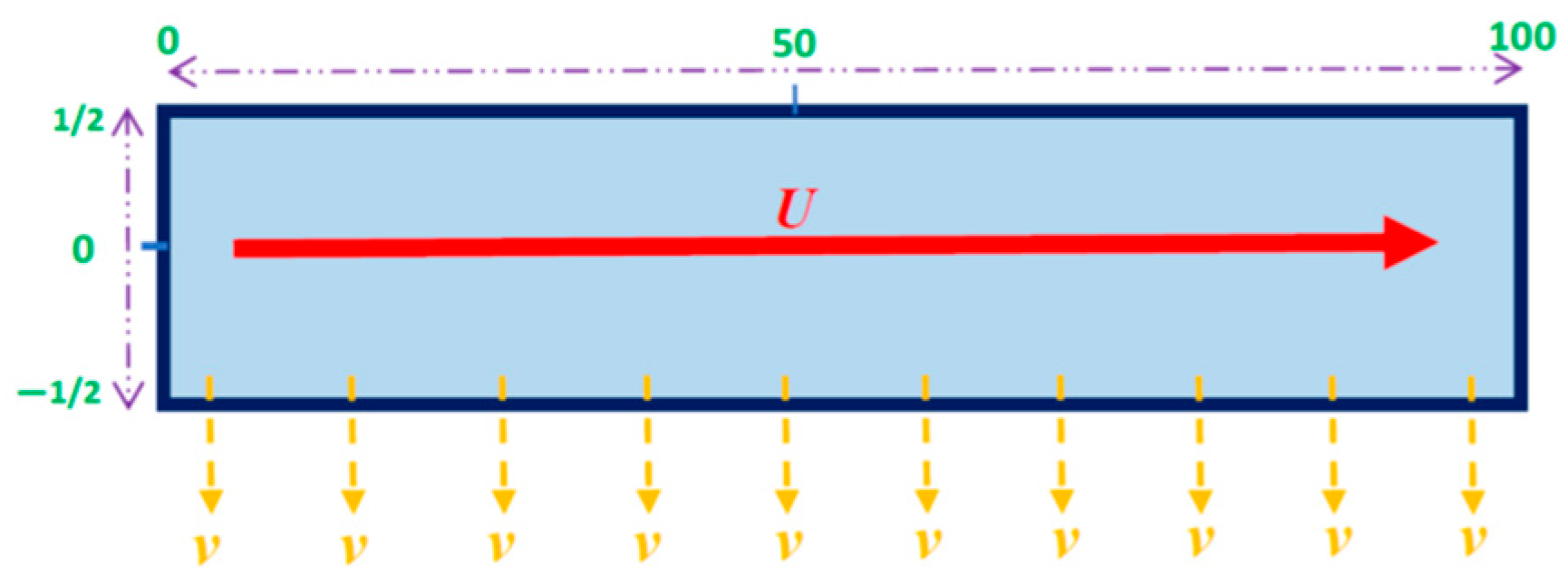

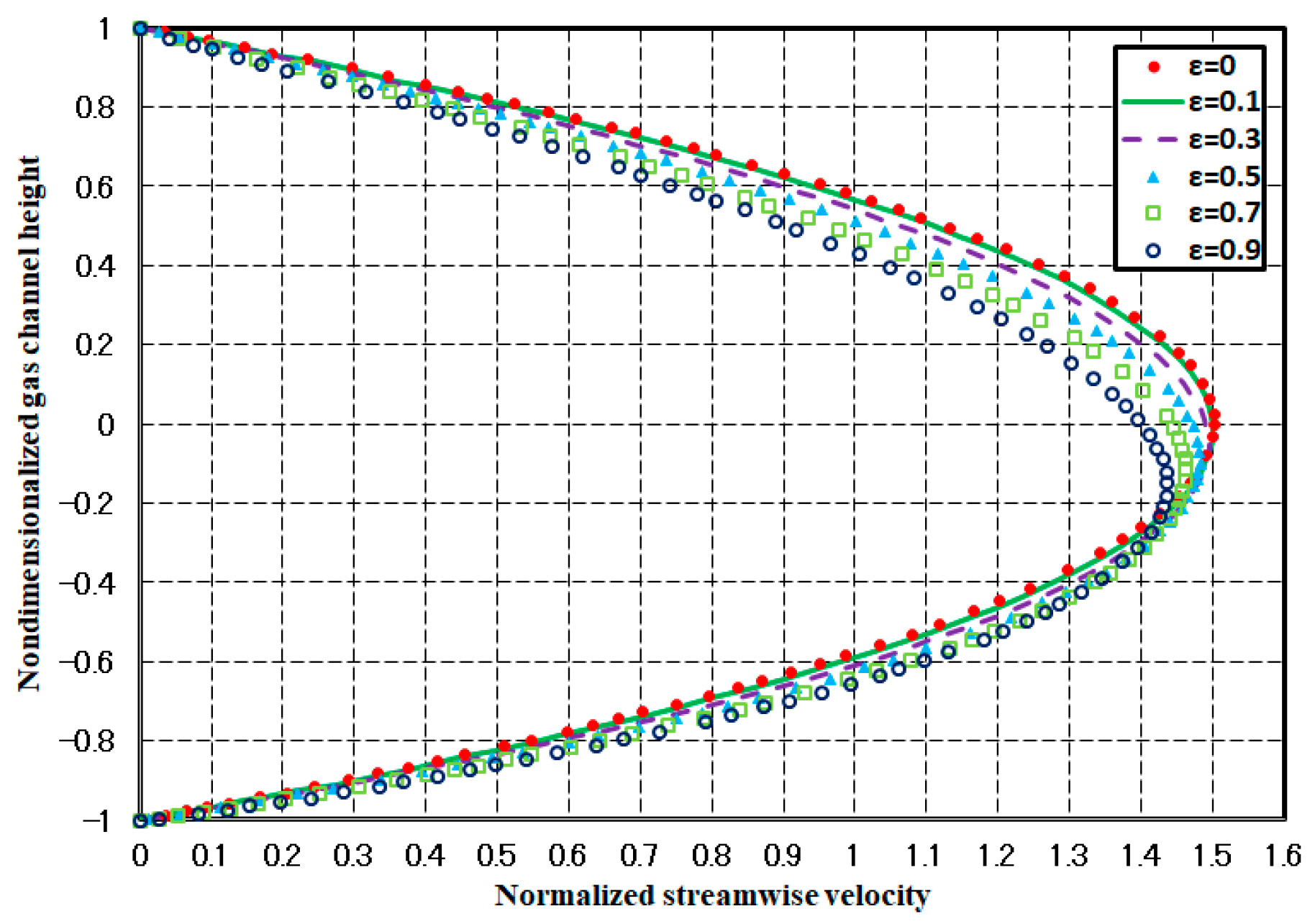

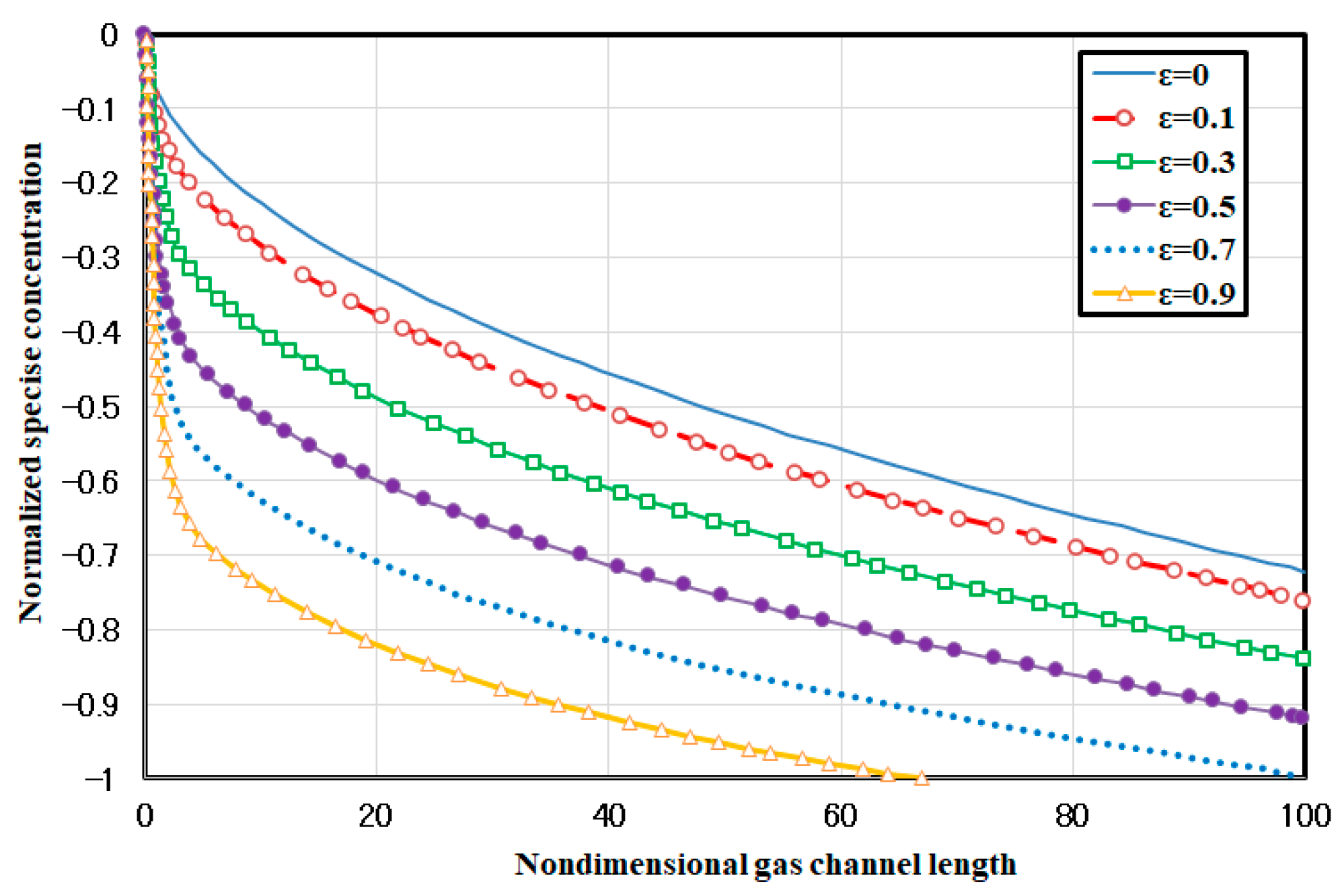
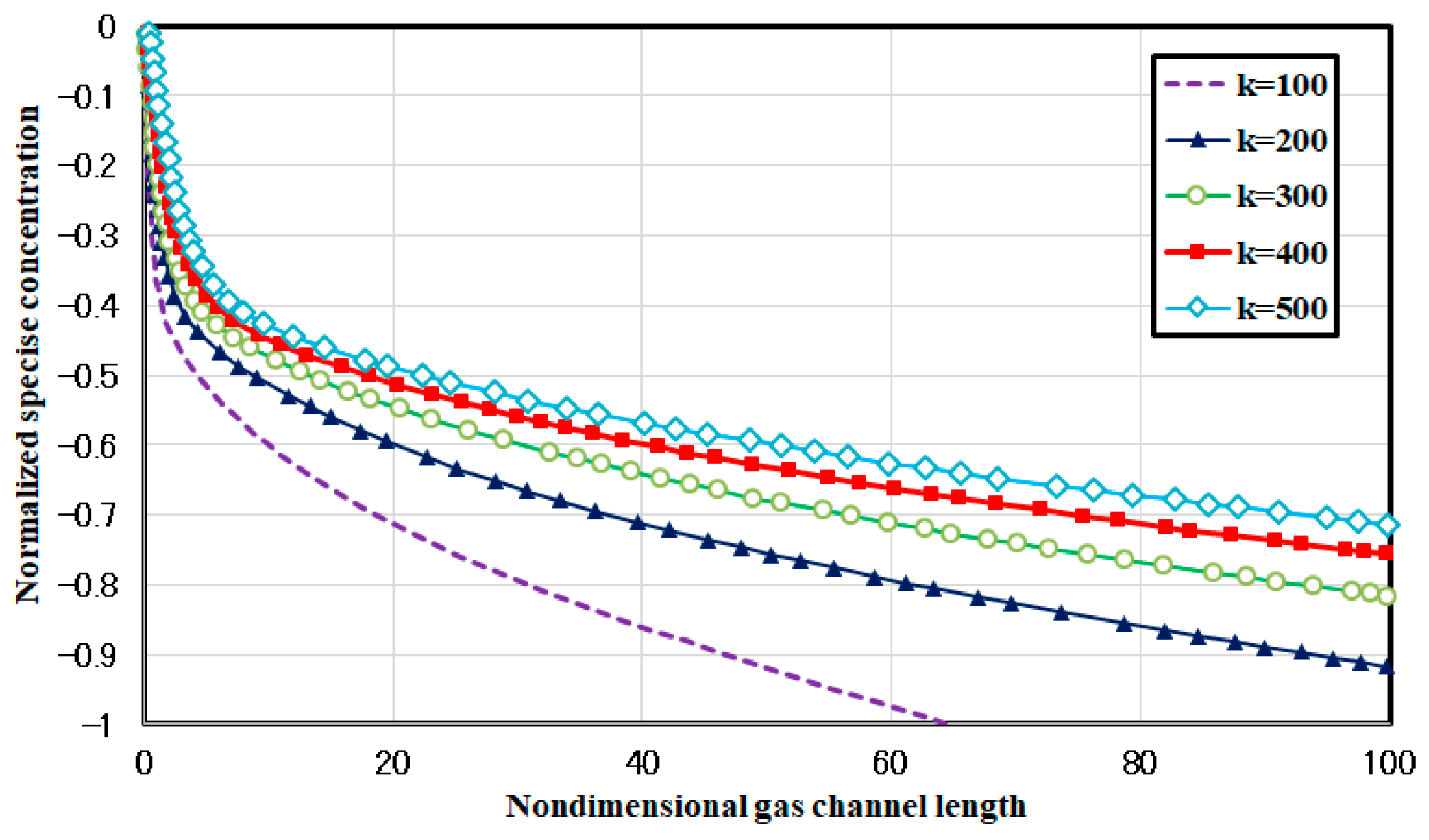
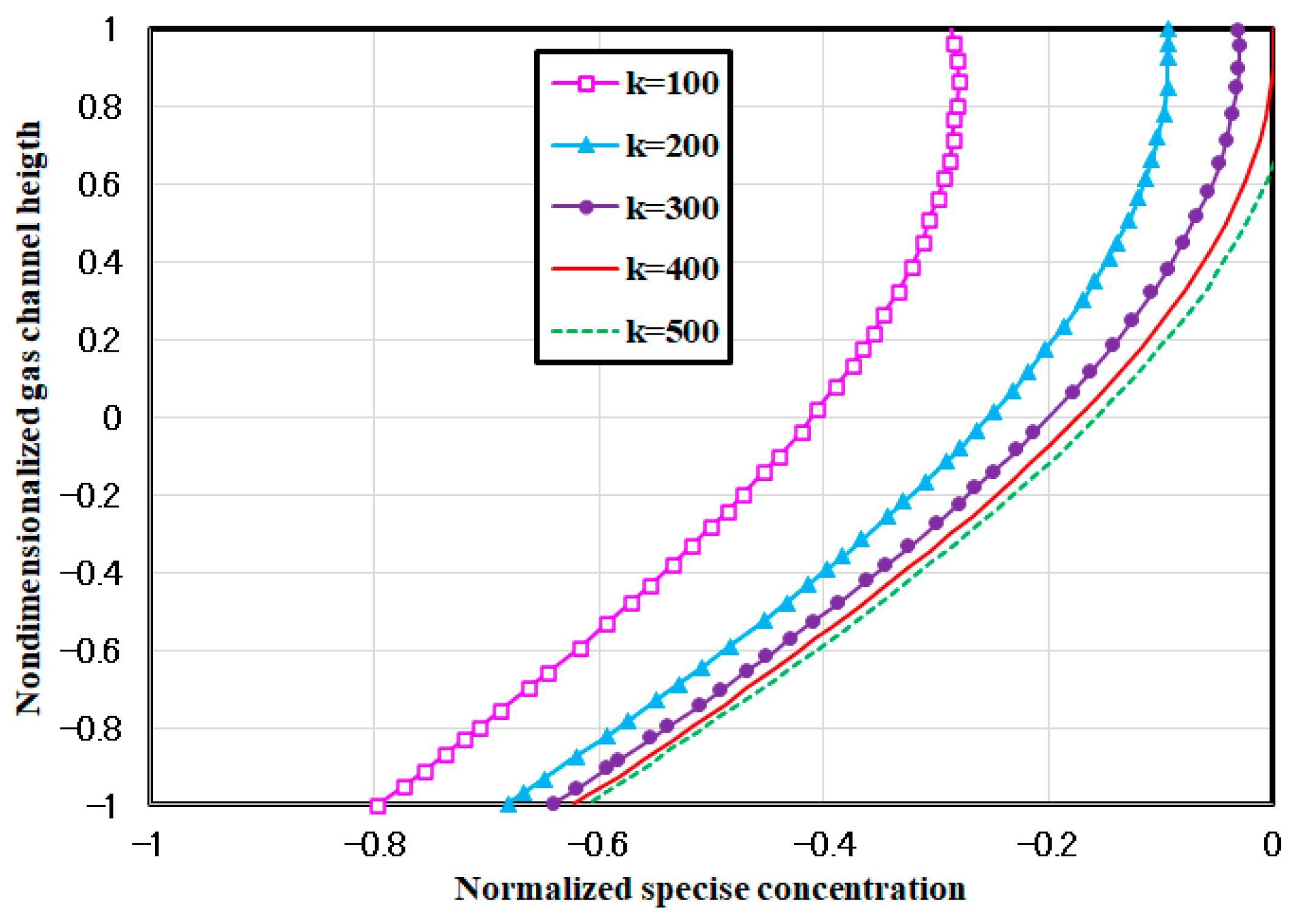

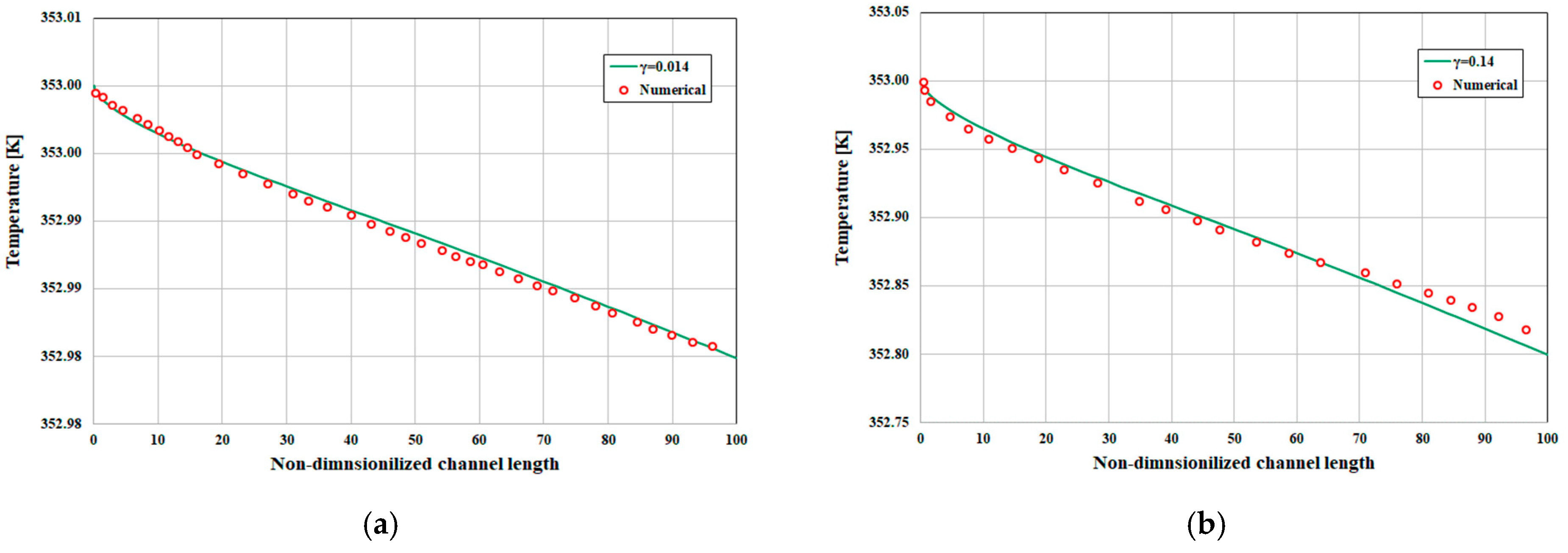
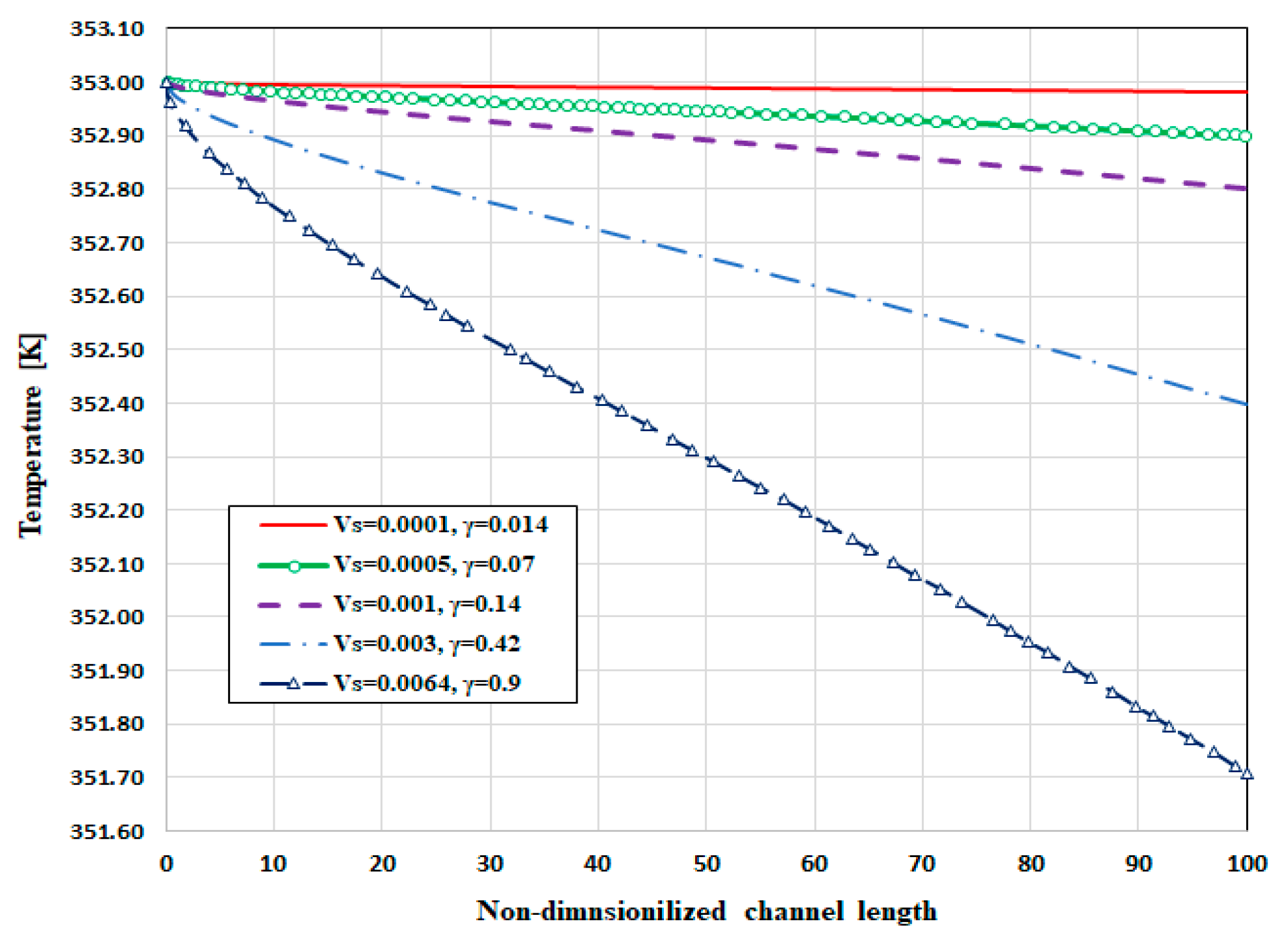

| Perturbation Parameter | Error | |
|---|---|---|
| 1 | ε = 0 | 0.014 |
| 2 | ε = 0.7 | 1.51 |
| Perturbation Parameter | Error | |
|---|---|---|
| 1 | ε = 0 | 0.5 |
| 2 | ε = 0.5 | 5.12 |
| The Value of the Perturbation Parameter | Error | |
|---|---|---|
| 1 | γ = 0.014 | 0.03 |
| 2 | γ = 0.14 | 0.45 |
Disclaimer/Publisher’s Note: The statements, opinions and data contained in all publications are solely those of the individual author(s) and contributor(s) and not of MDPI and/or the editor(s). MDPI and/or the editor(s) disclaim responsibility for any injury to people or property resulting from any ideas, methods, instructions or products referred to in the content. |
© 2023 by the authors. Licensee MDPI, Basel, Switzerland. This article is an open access article distributed under the terms and conditions of the Creative Commons Attribution (CC BY) license (https://creativecommons.org/licenses/by/4.0/).
Share and Cite
Ahmadi, N.; Rezazadeh, S. An Innovative Approach to Predict the Diffusion Rate of Reactant’s Effects on the Performance of the Polymer Electrolyte Membrane Fuel Cell. Mathematics 2023, 11, 4094. https://doi.org/10.3390/math11194094
Ahmadi N, Rezazadeh S. An Innovative Approach to Predict the Diffusion Rate of Reactant’s Effects on the Performance of the Polymer Electrolyte Membrane Fuel Cell. Mathematics. 2023; 11(19):4094. https://doi.org/10.3390/math11194094
Chicago/Turabian StyleAhmadi, Nima, and Sajad Rezazadeh. 2023. "An Innovative Approach to Predict the Diffusion Rate of Reactant’s Effects on the Performance of the Polymer Electrolyte Membrane Fuel Cell" Mathematics 11, no. 19: 4094. https://doi.org/10.3390/math11194094
APA StyleAhmadi, N., & Rezazadeh, S. (2023). An Innovative Approach to Predict the Diffusion Rate of Reactant’s Effects on the Performance of the Polymer Electrolyte Membrane Fuel Cell. Mathematics, 11(19), 4094. https://doi.org/10.3390/math11194094






